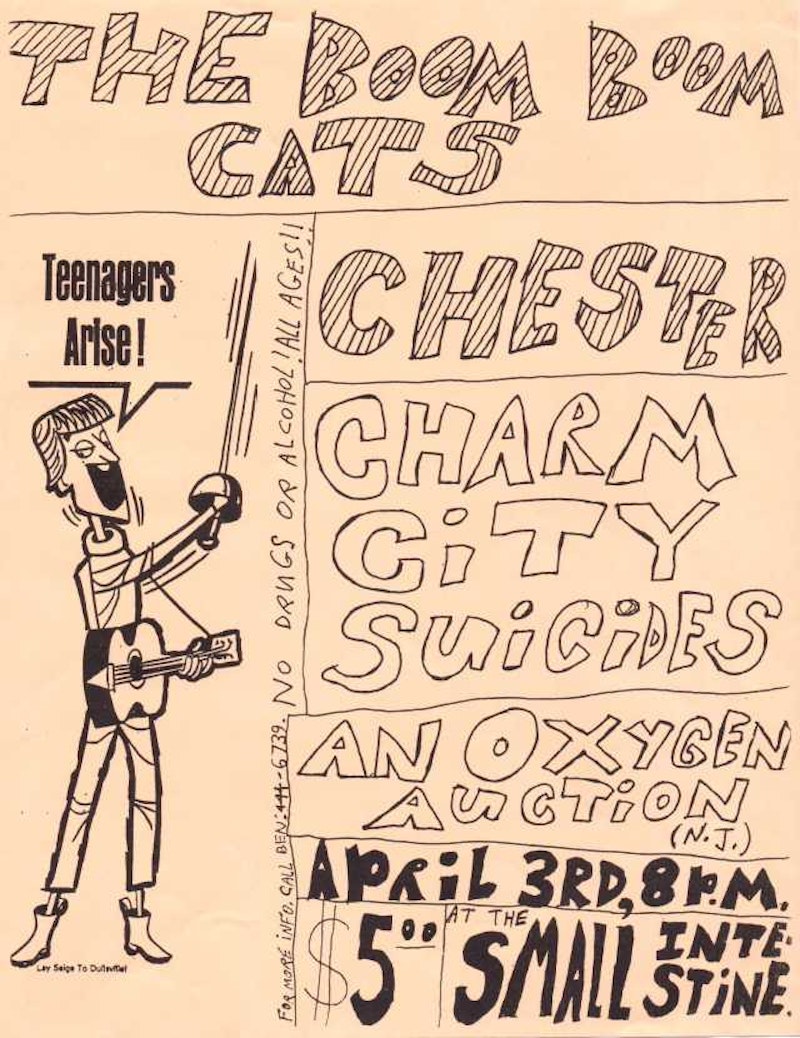Before a single sound came blasting from the shambolic amplifiers, before a single drum head could be bashed to pieces, before the gnarled screech of mad science could obliterate all parameters of tone, there came a procession of murky thuds. Scrap metal, barbed wire, chicken wire, chunks of rust, huge slabs of particle board and rotten wood, all of which had some long-forgotten utilitarian purpose. These were the ultimate thud-mongers of doomed power, a hail of objects that could transform any stage into a debris-choked temple or a blasphemy, a disaster waiting to happen or a miracle of chaos.
Before the dust settled four frenetic young people emerged and tore through the post-apocalyptic mass wielding musical instruments: the stereotypical tools of the rock ’n’ roll trade—electric guitar, bass, and drums, augmented by a bank of fried effects processors. They began making sounds that had little in common with rock music. It was a propulsive rhythmic noise that blurred the lines between sonic torture and catharsis.
An Oxygen Auction. That was the collective name of the audio terrorists responsible for this noisy visceral mess. An Oxygen Auction was less like a band, more like an explosive multi-media coincidence involving a bunch of bored misfits from the sleepy exurban borderlands of New Jersey and Pennsylvania. The members of AOA were guitarists Robert Jurgensen and Rachel Mackow, percussionist Doug Polgardy, and effects manipulator Sean White. Prior to forming most of them had been friends since the early-1990s, a time when they found themselves steeped in post-punk counter culture. They played music together, rolled out to gigs together, and made mixtapes for each other. Via the obscure label Chicken Farm Records, Jurgensen put out tapes and vinyl for various screamo, hardcore, and punk acts.
As 1990s rock became increasingly oversaturated, the four friends soon lost interest in emulating the era’s “flavor of the month” alt-rock trends. A shared obsession then developed thanks to a random trip down the radio dial. Thanks to the intense noise and experimental music recordings offered over the late-night airwaves of Princeton’s WPRB and East Orange, NJ’s WFMU, the four friends found a new calling. Discovering these esoteric sounds came at just the right time. The late-1990s were still awash in the post-grunge excess of pre-fab rebellion that turned many once-edgy underground aesthetics into innocuous past times for hobbyists and bandwagon hoppers. Guitar rock suddenly wasn’t extreme enough to express the fear and confusion that bubbled up as the 20th century wobbled toward oblivion.
Back then 911 was just a phone number. Nonetheless, violent anti-American extremists still popped up regularly in the Clinton era’s more thorough international news reports. The internet was primarily a haven for corporations, pornographers/sex workers, the Black Helicopter crew, celebrities, and marginalized nerds. Reality TV had just become a ubiquitous vampire sucking the life and humility out of fame addicts and desperate creative professionals. Blatant narcissism, obsessive schadenfreude, and self-sabotage then became easily marketable commodities that could make or break a career.
With this cultural meltdown as a backdrop, An Oxygen Auction ripped apart and randomly reassembled the most challenging elements of the provocative sound art and fringe music that inspired them. Their creation was a behemoth of hypnotic atonality and suspense, a monster that reflected everything scary and exhilarating about the dawn of a new age. When they spilled their tetanus-infested mass of junk on stage it was always the kickoff for each performance. It was also the perfect surrogate for the sloppy emotional baggage that came with late-century instability. While many late-90s artists created work that reviewed and celebrated 20th-century highlights, An Oxygen Auction had no affinity for the past, the present, or the future. At an AOA show progress became the ultimate transgression, something impossible to dominate or predict. This concept blazed in the chaotic rush of their improvisational outbursts.
Few people ever heard An Oxygen Auction. From 2000 to 2002 their recordings came out on one CDR, one lathe cut 7” and a compilation CDR (all now small press rarities); they had only a handful of rehearsals and all of their concerts were in the eastern U.S. The biggest shows they played were in Philadelphia at The Rotunda where they opened for Landed, and in Providence at The Safari Lounge, opening for Arab On Radar, Lightning Bolt, and Olneyville Sound System. AOA was frequently compared to some of these wild anti-rock bands. As the iconic on-stage garbage mass inevitably became a percussion instrument during their lengthy jams, AOA’s work could be viewed as a bastardized take on the scrapyard blowouts of Einstürzende Neubauten or Crash Worship.
Sound was only a tiny component of An Oxygen Auction. Consequently, comparing the group to anyone else is pointless. Their one-of-a-kind performances represented something more important than the shared context of any pop music scene or art movement. As the painfully loud amps melted ear drums, as they slashed their overdriven instruments into the air, as they stomped through piles of construction trash, An Oxygen Auction immortalized destruction’s role as an eternal spark of progress.
—Full disclosure: this writer became friends with the members of An Oxygen Auction during the early-1990s. Though time and geography have made their interactions less frequent today, the friendship endures. Jurgensen and Polgardy collaborated musically with me in the late-90s and 2000s.

